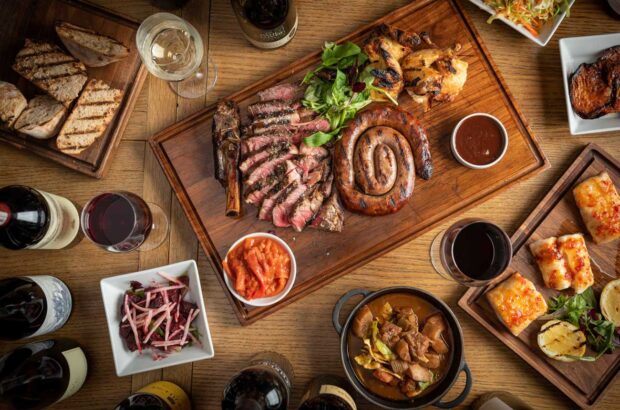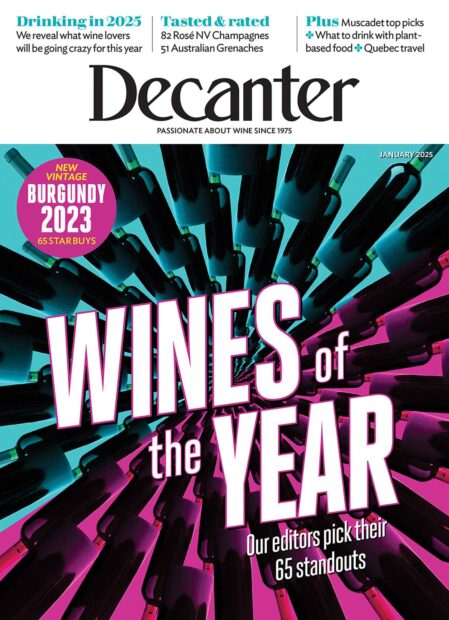Andrew Jefford checks out the Rhône less known.
Those who love the breadth, perfume and generosity of the wines of the Southern Rhône are intimately familiar with the Rhône’s left bank. This is Provençale Rhône, if you like: the great honey-white bowl of stonefields, terraces and garden villages which arcs out to the east, corralled by the jagged Dentelles de Montmirail, by austere Mont Ventoux, by the western end of the Vaucluse Massif, and finally by the prettier Montagne de Luberon and the Alpilles to the south. You’ll find most of the Southern Rhône’s villages here, and most of its crus, too.
What, though, of the right bank? There are just four named villages here, plus a couple of crus and some ancilliary appellations: a much less familiar wine landscape. I spent time at this year’s Découvertes en Vallée du Rhône trying to get to know them a bit better, and taste my way to understanding.
The right bank’s problem, if you like, is that it has no bowl. There are terraces but, relatively swiftly, they clamber up into the first foothills of the Cévennes, followed by the pasture and forest associated with altitude. There are certainly points of interest, but no uniformity. Let’s take the zones one by one.
Côtes du Vivarais
We’re in the southeast of the Ardèche, here – a plumb line dropped down from St Joseph. The limestone and marl soils are good-looking, and there’s no shortage of slopes – but altitudes are high (between 150m and 500m) and nights are cool. The whites and rosé wines in this appellation are much more successful than the rather thin and strained reds. There are, in point of fact, some very fine white wines hereabouts – but most are IGP. (For more on this unique white-wine story, see here). Grower Raphaël Pommier of the leading organic domain Notre Dame de Cousignac confirmed that most growers preferred to make IGP than AOC wine here – because sales are buoyant, and permitted yields are higher. This may be one of those rare parts of wine-growing France where IGP will always have the upper hand over AOC – unless the appellation regulations are modified to permit varietal Chardonnay and Viognier. That looks unlikely.
Notre Dame de Cousignac Blanc, Côtes du Vivarais 2016
A blend of equal portions of Grenache Blanc, Clairette and Marsanne, and grown at 150m. Pretty scents of white almond, honeysuckle and pink grapefruit, with a fresh, pithy, cleanly defined palate. Acid structured, but with some vinous warmth, too. 87
St Gervais and Chusclan
These ‘named village’ wines both come from the relatively confined valley of the Cèze, but there was little wine on show which seemed to be using the names, and none of it impressive. I have, though, had tasty light reds from Chusclan in the past, and the terraces open out into the main Rhône valley at this point, so there is potential. Chusclan is for red and rosé only, whereas St Gervais includes white too.
Laudun
This is a ‘named village’ on the move, and a name worth looking out for, especially for white wines: in the Southern Rhône, only Châteauneuf produces more white wine than Laudun (7,282 hl in 2016 compared to Laudun’s 3,766 hl – but Châteauneuf is more than six times larger than Laudun). It was the whites of Laudun which the celebrated Ardechois writer and agricultural thinker Olivier de Serres picked out for praise in the early C17, and there’s lots more room for expansion here, considering that 81% of Laudun’s production is still red. Its slopes, benches and terraces open up on to the main Rhône valley from the little river Tave.
Maison Brotte, Bord Elégance Blanc, Côtes du Rhône-Villages-Laudun 2016
The blend here is 70 per cent Grenache Blanc with the balance from Clairette, Viognier and Roussanne. Nettle-cream scents with a little exotic fruit, with ripe summer fruits on the palate and a pithy, sappy, lemony finish. 90
Ch Courac Blanc, Côtes du Rhône-Villages-Laudun 2016
I had a chance to taste both this vintage and its predecessor, and both are excellent. It’s very southern: a Clairette Blanc/Grenache Blanc blend, but all the better for that: apple, cucumber and fennel scents, with mouthfilling, creamy, aniseed-rich flavours with just enough ‘stony’ edge and ripe acidity to keep it fresh and vibrant; the creamy anis steals back into the finish. 91
Domaine de Maravilhas, Maestral Blanc, Côtes du Rhône-Villages-Laudun 2014
I can’t resist mentioning this wine since it is pure Clairette: one of the traditional glories of the South of France, yet hard to find on its own. It smells of fields of grain with a wild-herb drift behind, while the palate is clean, fresh and citrusy. At just 12.5% I suspect it’s been picked a little too early, before the switch is flipped on Clairette’s full resonance. Good all the same. 89
Domaine Pélaquié Blanc, Côtes du Rhône-Villages-Laudun 2015
A complex blend (Clairette, Grenache, Marsanne, Roussanne, Viognier and Bourboulenc): perfume grass scents and a bright, focussed, fresh palate with plenty of drive and thrust to it. There’s nothing evident about the flavours, though – a fruit and meadowflower mix in which no variety has the upper hand. 89
Lirac and Tavel
These two crus are best considered together. The zones don’t overlap (Tavel lies south of Lirac), but since Tavel is for rosé alone, many producers have land in both areas and use Lirac for their reds and white, and Tavel for rosé. I will look at the ‘gastronomic rosé’ of Tavel (and the challenge posed to it by the success of Provence’s ultra-pale rosés) on another occasion.
Lirac is unquestionably the finest site on the Southern Rhône’s right bank for red wines, and in many ways it’s a great red in hiding, lurking in the shadows of Châteauneuf just across the river. Lirac can’t quite match Châteauneuf’s finest sites for power, thrust and thunder – but you might not want that, preferring the softer and more velvety charms of Lirac, both concentrated and utterly beguiling on occasion. There is a little limestone plateau land, but most Lirac vineyards are planted on the familiar rolled pebble soils and sands which you’ll also find over to the east, though they tend to lie a little lower here.
Le Clos des Sources, Lirac 2015
Pure perfumed finesse: thyme, fennel, lavender, pine and cistus play through the wine, which is both soft and tender yet sustained and resonant. 92
Ch Mont-Redon, Lirac 2014
Translucent in colour, with soft, ripe, savoury aromas and a deep-dropping flavour which combines plummy fruits and the complexities of laurel, thyme and lavender; softly and gracefully structured, too. 92
Domaine de la Mordorée, Lirac 2015
By the time I got to the Mordorée stand, samples of its outstanding Reine des Bois cuvée, an appellation benchmark, had been exhausted, but the ‘classique’ is impressive in the fine 2015 vintage, too: softly spiced mulberry and blackberry scents, with a palate of teased, nuanced ripeness, with tar, stone and resin behind those softly spicy fruits. 91
Signargues
Regular readers may recall my recent blog about ‘the other Châteauneuf’ – Châteauneuf de Gadagne (https://www.decanter.com/wine-news/opinion/jefford-on-monday/gadagne-the-other-chateauneuf-354772/). If there is a right-bank echo of Gadagne, it is probably Signargues, which is yet another set of rolled-pebble vineyards and sands linking four villages just a few kilometres west of Avignon. The name (which is a plateau, not a village as such), I fear, will be a handicap; the easier-to-pronounce Saze or Rochefort might have been a better bet. The quality potential for reds here looks good for those prepared to invest in quality.
Domaine des Andrines, Côtes du Rhône-Villages-Signargues 2016
Ripeness seemed to be an issue for some of the Signargues reds, but not this wine, which has ample cherry-plum fruit in juicy, lip-smacking style. There’s fresh acidity and relatively brisk tannins, so after Lirac you’d guess that the site has a little more elevation. Plenty of classic Rhône spiciness to finsh. 90
Duché d’Uzès
My hunt around the right-bank appellations concluded with a look at this intriguing appellation, awarded after many years’ efforts in 2012. Is it Rhône? Is it Languedoc? We’ve retreated well back from the river here, up into the Cévennes – and having tasted the wines, it seems to me that the Cévenol foothill identity might well be the most appropriate. The words chosen, after all, by the growers themselves to describe their wines are ‘ciselés, aériens’ (chiselled and aerial). Whites can work very well here (Mathilde Chapoutier has selected one such for her range), but only the most ambitious reds seem to get beyond a faintly green pepperiness at present.
Mas de Volques, Dolia Alba, Duché d’Uzès 2015
Blended principally from Roussanne and Viognier and given barrel-fermentation, this white deftly combined freshness and richness, while the perfumed summer-fruit notes were achieved with great subtlety. 89
Domaine de Sollier, Les Linthes, Duché d’Uzès 2014
Blended principally from Syrah (which looks happy here) and just 20% Grenache, both grown at over 300m, this has real mountain-fresh qualities with cola, coal and peppery notes. Nonetheless there are some firm, structuring tannins, and the fruit has a mouth-coating quality. 88
More Andrew Jefford columns on Decanter.com:

Jefford on Monday: Unpleasant wine, tipsy citizens
A brief history of French wine...

Jefford on Monday: Marie Maria – a Madiran re-boot
An insurrection in southern France...

Jefford on Monday: Wine stories
Why don't wine writers tell more stories?

Jefford on Monday: The alpha and omega wine
Andrew Jefford recommends wines to try...







